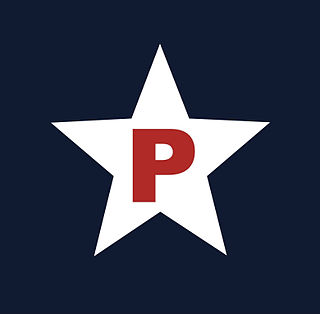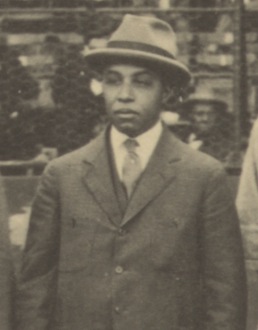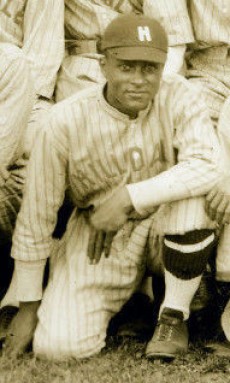
Oscar McKinley Charleston was an American center fielder and manager in Negro league baseball. Over his 43-year baseball career, Charleston played or managed with more than a dozen teams, including the Homestead Grays and the Pittsburgh Crawfords, Negro league baseball's leading teams in the 1930s. He also played nine winter seasons in Cuba and in numerous exhibition games against white major leaguers. He was posthumously inducted into the National Baseball Hall of Fame in 1976.

The Mutual Association of Eastern Colored Clubs, more commonly known as the Eastern Colored League (ECL), was one of the several Negro leagues, which operated during the time organized baseball was segregated.

William Julius "Judy" Johnson was an American professional third baseman and manager whose career in Negro league baseball spanned 17 seasons, from 1921 to 1937. Slight of build, Johnson never developed as a power threat but achieved his greatest success as a contact hitter and an intuitive defenseman. Johnson is regarded as one of the greatest third basemen of the Negro leagues. In 1975, he was elected into the Baseball Hall of Fame after being nominated by the Negro Leagues Committee.

National League Park, commonly referred to as the Baker Bowl after 1923, was a baseball stadium home to the Philadelphia Phillies from 1887 until 1938, and the first home field of the Philadelphia Eagles from 1933 to 1935. It opened in 1887 with a capacity of 12,500. It burned down in 1894 and was rebuilt in 1895 as the first ballpark constructed primarily of steel and brick and with a cantilevered upper deck.

James Raleigh "Biz" Mackey was an American catcher and manager in Negro league baseball. He played for the Indianapolis ABCs, New York Lincoln Giants, Hilldale Daisies, Philadelphia Royal Giants, Philadelphia Stars, Washington / Baltimore Elite Giants, and Newark Dodgers / Eagles.

Louis Santop Loftin was an American baseball catcher in the Negro leagues. He became "one of the earliest superstars" and "black baseball's first legitimate home-run slugger" (Riley), and was elected to the Baseball Hall of Fame in 2006. Some sources show a birth year of 1890, but his Navy records and Baseball Hall of Fame records support the earlier date.

The Philadelphia Stars were a Negro league baseball team from Philadelphia. The Stars were founded in 1933 when Ed Bolden returned to professional black baseball after being idle since early 1930. The Stars were an independent ball club in 1933, a member of the Negro National League from 1934 until the League's collapse following the 1948 season, and affiliated with the Negro American League from 1949 to 1952.

The Hilldale Athletic Club were an American professional Negro league baseball team based in Darby, Pennsylvania, west of Philadelphia.
The Indianapolis ABCs were a Negro league baseball team that played both as an independent club and as a charter member of the first Negro National League (NNL). They claimed the western championship of black baseball in 1915 and 1916, and finished second in the 1922 NNL. Among their best players were Baseball Hall of Fame members Oscar Charleston, Biz Mackey, and Ben Taylor.
The 1924 Colored World Series was a best-of-nine match-up between the Negro National League champion Kansas City Monarchs and the Eastern Colored League champion Hilldale. In a ten-game series, the Monarchs narrowly defeated Hilldale 5 games to 4, with one tie game. It was the first World Series between the respective champions of the NNL and ECL. It was the second year of existence for the ECL, but no agreement could be reached in 1923 for a postseason series, owing primarily to unresolved disputes between the leagues. Five members of the Baseball Hall of Fame participated in the series: Biz Mackey, Judy Johnson, and Louis Santop played for Hilldale, while Bullet Rogan and José Méndez played for the Monarchs. In addition, Monarchs owner J. L. Wilkinson was also inducted into the Hall.

J. P. Small Memorial Stadium is a baseball park in Jacksonville, Florida. It is located in the Durkeeville community in northwest Jacksonville. Constructed in 1912 and rebuilt in 1936, it was the city's first municipal recreation field, and served as its primary baseball park before the construction of Wolfson Park in 1954. Throughout the years the stadium has been known at various times as Barrs Field, Durkee Field, and the Myrtle Avenue Ball Park.
The P.R.R. YMCA Athletic Field, also known as Penmar Park and commonly referred to in the 1930s and 1940s as the 44th and Parkside ballpark, was an athletic field and ballpark in West Philadelphia from as early as the 1890s to the early 1950s. It was built by the Pennsylvania Railroad YMCA for use by its employees. Behind the right-field fence stood the roundhouse of the main yard of the Pennsylvania Railroad. The Negro league baseball Philadelphia Stars played home games at the park from 1936 until 1952.

Edward Bolden was an American baseball executive and owner in the Negro leagues.

Paul Eugene "Country Jake" Stephens was an American baseball player known for his slight stature, speed, and defense at the shortstop position. He played in the Negro leagues for 4 teams (1921–1937).

George Washington "Dibo" Johnson was an American baseball outfielder in the Negro leagues.
The 1925 Colored World Series was the second edition of the championship series in Negro league baseball. The series featured a rematch between the Hilldale Club of Darby, Pennsylvania, champion of the Eastern Colored League (ECL), and the Kansas City Monarchs, champion of the Negro National League (NNL) and winner of the previous year's match in the first Colored World Series. In 1925, Hilldale won the best-of-nine series, five games to one.
The 1925 Hilldale Club baseball team represented the Hilldale Club in the Eastern Colored League (ECL) during the 1925 baseball season. The team compiled a 53–18–1 (.743) record, won the ECL pennant, and defeated the Kansas City Monarchs in the 1925 Colored World Series. Frank Warfield was Hilldale's player-manager. The team played its home games at Hilldale Park in Darby, Pennsylvania, a Philadelphia suburb.
The 1923 Hilldale Club baseball team represented the Hilldale Club in the Eastern Colored League (ECL) during the 1923 baseball season. The team compiled a 40–21–1 (.653) record and won the ECL pennant. John Henry Lloyd was Hilldale's player-manager. The team played its home games at Hilldale Park in Darby, Pennsylvania, a Philadelphia suburb.












